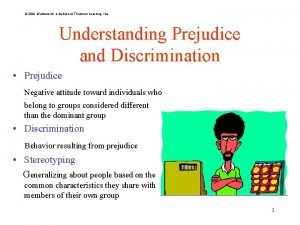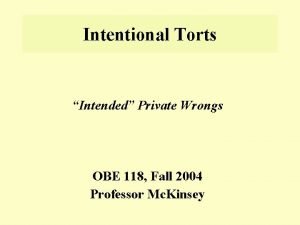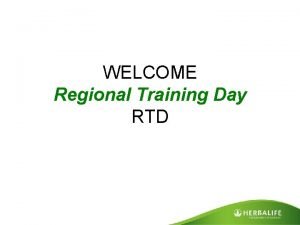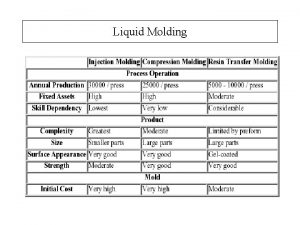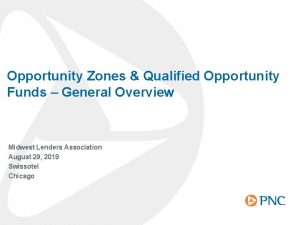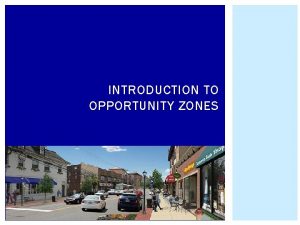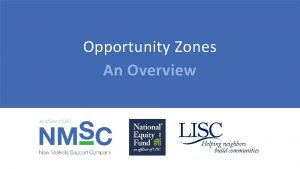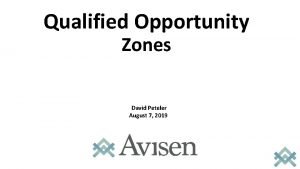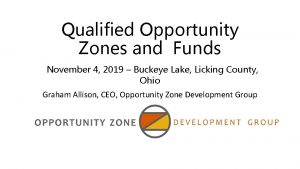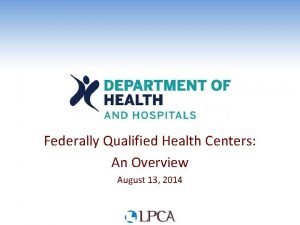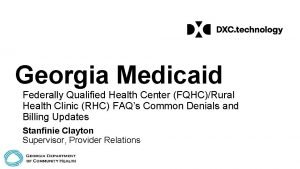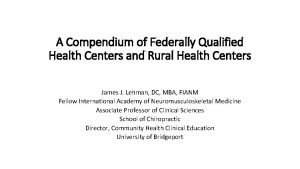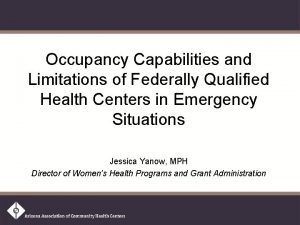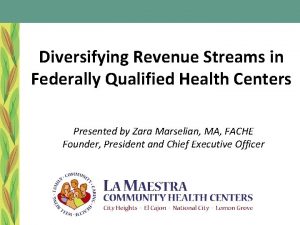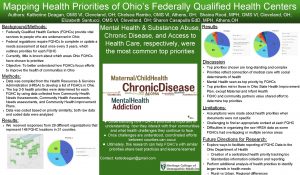Federally Qualified Opportunity Zones an Opportunity for Natural























- Slides: 23

Federally Qualified Opportunity Zones: an Opportunity for Natural Experiments on Place-based Programming and Neighborhood Change Jana A. Hirsch, Yuzhe Zhao, Usama Bilal, Kathryn M. Neckerman, Yvonne L. Michael

Background: Tax Cuts and Jobs Act • December 22, 2017 • Qualified Opportunity Zones (QOZ) • Census tract boundaries • Since passage: 8700+ QOZ • 12% of U. S. tracts • All 50 states, DC, and five US possessions • Provides a tax benefit to investors who invest eligible capital into QOZ

QOZ Eligibility: Eligible Tracts Adjacent Eligible Tracts • Low Income: • Adjacent to qualifying lowincome tracts if median family income did not exceed 125% of the median family income of the adjacent qualifying tract • Poverty rate of at least 20% • Median family income no greater than 80% of the state median for nonmetropolitan tracts or the state or metropolitan-area median (whichever is higher) for metropolitan tracts Uses ACS 2011 -2015 data

Law uses three mechanisms to incentivize investment within QOZ*: 1. Temporary deferral of taxes on previously earned capital gains that are invested in a QOZ 2. Reduction in taxes on previously earned capital gains, if assets in the QOZ are held long enough 3. Permanent exclusion of taxes on any new capital gains earned on assets in the QOZ. *Incentive only applies to those with previously earned capital gains who put these into Qualified Opportunity Funds (QOF) to spend within QOZ

QOZ here in Philadelphia Explore more at: http: //dced. maps. arcgi s. com/home/webmap/ viewer. html? webmap= b 0 bd 4 d 703 ddc 498 fb 0 a 993 a 00 d 77 ed 4 c

Potential Public Health Impacts • Shifting neighborhoods • Investments in new businesses • Changing the physical or retail environment • Potential for displacement (and worsening health disparities) • Different impacts by population Casita Triste (Art project in Dallas)

New Paper out 1/16: Health and Health-Related Resources in Newly Designated Federally Qualified Opportunity Zones: United States, 2012– 2016

Describing conditions at baseline is imperative for assessing public health policy impacts AIM: To compare health and healthy resources in newly designated QOZ, eligible but not designated tracts, and ineligible tracts in large U. S. cities. All U. S. Census Tracts in largest cities Eligible Tracts Designated Tracts

24, 409 contiguous U. S. census tracts U. S. Census Bureau 2016 TIGER Line Geodatabase files representing 2010 geographies. ACS 2012 -2016. Data Sources NETS data from RECVD (businesses) (https: //sites. google. com/view/recvd-team-project-site/home) 500 Cities health dataset*(health/behaviors) (https: //www. cdc. gov/500 cities/index. htm) USA LEEP data (https: //www. cdc. gov/nchs/nvss/usaleep. html) U. S. Dept Treasury (QOZ designations as of 12/14/2018) (https: //www. cdfifund. gov/Pages/Opportunity-Zones. aspx) *The city boundaries used for the 500 Cities dataset were delineated by block rather than tract. Therefore, tracts were also excluded if less than 80% of their population was covered by the 500 Cities dataset (calculated as population from 500 Cities dataset compared to population from Census 2010).

RECVD Project Data Included in Manuscript Healthcare facilities all clinical treatment, hospitals and inpatient care, ambulatory care, kidney centers, physical therapist, residential facilities with health care, all pharmacies and drug stores Physical activity resources all physical activity facilities, multi-use facilities, walkable destinations for daily living, greenness (from NLCD) Food stores all food stores, healthy food sales, all unhealthy food sources, all fast food Other healthrelated businesses cognitive enrichment destinations, frequent social destinations, individual and family social services, bars and nightclubs serving alcohol, liquor stores)

Health Data Included (model-based estimates from 500 Cities & USALEEP) unhealthy behaviors health outcomes prevention practices physical inactivity, drinking, smoking, sleeping, obesity poor physical health, poor mental health, stroke, coronary heart disease, cancer, arthritis, diabetes, high cholesterol, high blood pressure, adult asthma, chronic obstructive pulmonary disease, chronic kidney disease, all teeth lost, life expectancy at birth (USALEEP) current lack of health insurance, clinical preventive services, routine checkups, dental visits, cholesterol screening, blood pressure medication, colonoscopy, mammography, pap smear

Analyses aimed to describe baseline conditions • Means and standard deviations (SD) across QOZ categories • Repeated by state • Differences between designated QOZ and eligible but not designated tracts (adjusting for total disparity)

Example map

Example difference adjusting for total disparity Difference between the mean value of proportion poor physical health (2016) in tracts designated as QOZ compared to eligible, not designated tracts by state plotted against the coefficient of variation (total disparity). For “negative outcomes” such as this (i. e. where we expect targeted designation to mean more positive differences), states above the line are doing best and states below the line are doing worse at targeting tracts that need investment.

Online Dashboard of Results https: //neighborho oddata. shinyapps. io /FQOZ_Benchmark/

Verbal/written results: NETS • Eligible but not designated and ineligible tracts, on average QOZ had smaller, younger, and more racially/ethnically diverse populations • QOZ and eligible tracts had lower socioeconomic status (SES) than ineligible tracts • Designated QOZ had lower overall clinical treatment facility density, primarily driven by less ambulatory care • Higher density of hospitals and inpatient care and pharmacies or drug stores • QOZ had substantially lower density of physical activity resources, including multi-use facilities and proportion green, than ineligible tracts but were similar to eligible tracts across these resources. • QOZ had a higher density of walkable destinations for daily living than other eligible or ineligible tracts • QOZ had more food stores, primarily driven by a higher density of unhealthy food sources, including fast food. • Consistent with their higher walkability, QOZ had more social destinations and social services. • QOZ and other eligible tracts had a much higher density of liquor stores than ineligible tracts.

Verbal/written results: Health • Prevalence of all unhealthy behaviors except binge drinking was highest in QOZ, intermediate in other eligible tracts, and lowest in ineligible tracts • Binge drinking showed a reverse pattern, with ineligible tracts having the highest prevalence • Designated QOZ had the poorest health outcomes across all measures except cancer • Prevention practices were less consistent; • While QOZ had a higher proportion without health insurance and a lower proportion up-to-date on clinical preventive services, cholesterol screening, colonoscopy and visits to the dentist • Also had higher prevalence of visits to the doctor for routine checkup. There was no difference in proportions with blood pressure medication, mammogram, and Papanicolaou smear use • The difference in life expectancy in QOZ was 6. 3 - and 2. 3 -years compared to ineligible and eligible but not designated areas, respectively

Discussion of Findings • Residents of QOZ had poorer health, health behaviors, and prevention practices • Previous research on place-based policies is limited • Need for evaluation • Contradictory impacts • QOZ could improve access to jobs and health resources in high-need areas • Gains could be negated by gentrification and displacement of low-income residents • QOZ may become a transformative force for health within our communities if tracked, assessed, and managed carefully

QOZ As A Unique Policy to Study • Compared to other programs: • No business assistance, infrastructure spending, and job training • Unclear tax incentives alone will produce the same effects • Differential designation by states • Policy does not ensure equal (or any) investment across all QOZ • Different policy impacts for different investment assets • No system to track QOF-QOZ spending

Future evaluation efforts • Facilitate evaluation • Broad eligibility criteria and only modest targeting • Ample numbers of comparison tracts similar to QOZ tracts receiving the policy “treatment” • Selection of QOZ across multiple contexts • Consideration of the moderating effects of geographic and policy context • State variation in the extent of targeting provides a natural experiment • Challenges • nonrandom selection of QOZ • very limited monitoring and transparency • difficulty of documenting displacement of existing residents

What Public Health will need to track 1) Distribution of investments (both from QOF and other private investors) into QOZ and other tracts 2) Changes that may occur in the built and social environment using data similar to that benchmarked in this report 3) Population dynamics in census tracts, with a special focus on displacement 4) Changes in health behaviors and outcomes at the individual and neighborhood level

Strategies for local jurisdictions • Local Transparency: add tracking of QOF investments to land use variance forms, building permits, or other related transactions • Affordable housing incentives: inclusionary zoning that incentivizes or subsidizes affordable housing to remediate displacement and increase benefits for existing residents • Zoning: Zone land uses for health-promoting resources or create potential development incentives. Public space requirements, landscapes that facilitate green space, local art, street scale for walkability, and other similar features • Pair public investment with private investment: Build new parks, trails, bike lanes, transit, or other amenities in QOZ. Spur returns on investments for QOF and thus increase the attractiveness of that QOZ compared to a tract without public investment. Requirements on private investments for neighborhood amenities (e. g. public art, green space) may have similar affects. • Disparities: Attention in future evaluations must be paid to changes in disparities at the state or city level. • Local Engagement: Identifying existing community health strengths that could appeal to QOF investment. Mapping neighborhood health-related gaps that might be filled through additional investment. Requiring and performing health impact assessments for all developments in QOZ may clearly articulate potential outcomes of individual QOF investment.

Activity: Leveraging for UHC research • Things that could be leveraged: • Broad, nationallyrelevant • Easy to link to cohorts (tracts) • States designated them differently • Local concentration in Philadelphia • Seeking: • Collaborations • Suggestions of funding • Creative study designs
 Federally protected classes
Federally protected classes Federally protected classes
Federally protected classes Federally protected classes
Federally protected classes Federally protected classes
Federally protected classes Equator temperature
Equator temperature How do littoral zones differ from riparian zones?
How do littoral zones differ from riparian zones? George ashton lisc
George ashton lisc Opportunity zones nevada
Opportunity zones nevada An opportunity assessment plan
An opportunity assessment plan Vqip
Vqip Qualified privilege
Qualified privilege My herbalife volume points list
My herbalife volume points list What is the nec definition of a qualified person
What is the nec definition of a qualified person Creating a forensic duplicate of a hard drive
Creating a forensic duplicate of a hard drive Ppv herbalife
Ppv herbalife Herbalife unencumbered volume points
Herbalife unencumbered volume points Sqrtm - same-qualified resin transfer moulding
Sqrtm - same-qualified resin transfer moulding Space qualified camera
Space qualified camera Cbltdli
Cbltdli Qualified evidence
Qualified evidence Herbalife world team benefits
Herbalife world team benefits Space qualified fiber optic cable
Space qualified fiber optic cable Ref-qualified member functions
Ref-qualified member functions Qualified products list search
Qualified products list search


